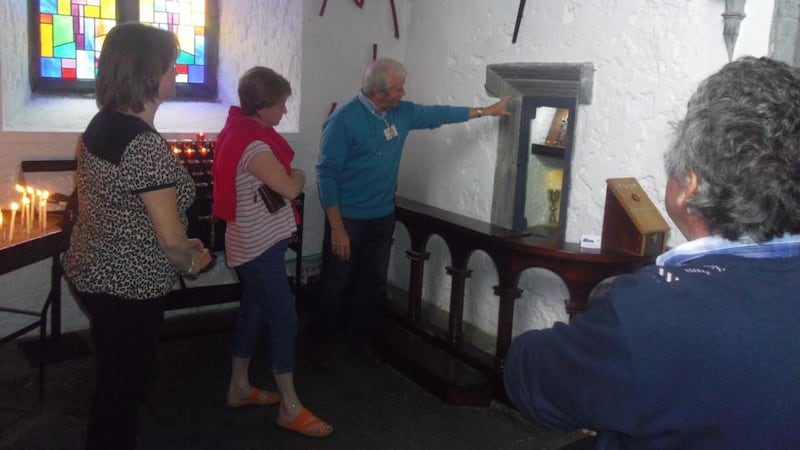It is one of Ireland's most visited attractions, yet the surrounding area has, so far, gained little from tourist spend. Recent Fáilte Ireland figures report that the Cistercian Abbey at Holycross, Co Tipperary enticed a footfall estimated at 240,000 putting it in the top 10 among Ireland's non fee-paying attractions.
Such impressive statistics have not translated into tourism gold, however, for Holy Cross has, since its restoration, remained essentially a place of sanctity and prayer with most visitors coming as day-trippers for devotional or spiritual reasons.
Now the abbey, which in its medieval heyday attracted many European pilgrims to its relic of the true cross, is reclaiming its inheritance as a honeypot for mainstream visitors wishing to better understand medieval life.

An initiative funded by the north and south Tipperary Leader rural development programmes, which is now likely to be replicated by others aspiring to benefit from history-based tourism, provided training for individuals wishing to become local guides. Graduates from this course are not only providing tours within the abbey, they are also re-imagining and interpreting life as it was in Holycross village during medieval times.
John Burke, chairman of Holycross Community Network, ascribes the initial idea for unlocking the tourism potential of the abbey to local business people.
He observed visitors coming to Holy Cross and then leaving again when no guide or explanation of the abbey was available. “We now use interpretation to keep these people at the site,” says Burke. “We are now catering for about 30 tours a month.”
"We have a panel of about a dozen trained guides," says Burke. "Some are retired, so there is always someone available. Our guides are local volunteers and this is a huge advantage for they are deeply interested in the abbey and bring lots of life experience to the tours. We don't charge for the guiding service but donations to defray costs are gladly accepted."
Functioning church
And how are the clergy reacting to snap-happy tourists traversing a place of sanctity? "No problem," replies Burke "our priests are very supportive and involved with our committee. Tours are designed so they can be delivered without entering the church when religious services are in progress. Otherwise people are reminded that the abbey is a functioning parish church and place of prayer – so far there has been no problem."
I join a Sunday afternoon tour. People are slow to assemble, as it is the day Dublin are up against Cork in the All-Ireland semi-final, while the nearby Cabragh wetlands are having their popular open day. Holy Cross is one of numerous such European abbeys, all built in the same way. A blind monk, it has been said, couldn’t get lost in any Cistercian abbey and guide Tom Gallagher’s challenge is to avoid blandly regurgitating St Benedict’s rules for abbey governance and instead unearth the local storyline.
He tells about the ruthless conformity of Cistercianism, but briefly, before moving on to the strong link between the abbey and the community. He has clearly researched this deeply and has everyone onside when he speaks of his own deep, multi-generational ties with Holycross and of how the local people came together to support the 1970s restoration. He likens the medieval abbey to a modern multinational employer creating satellite enterprises in the locality – masons, millers, distillers, weavers , farmers, fishermen.
Monks were renowned for situating abbeys in fertile locations and, with 8,000 bountiful acres, Holy Cross was a wealthy foundation which provided the resources for the highest flowering of Cistercian art in Ireland. The great abbey windows are expensively ornate, the cloisters lavishly decorative.
We are slightly taken aback, however, when Gallagher points out the unvarnished truth that, even in monastic life, inequality and exploitation inevitably followed wealth. The abbot’s quarters were the lap of medieval luxury and comparable in size to any Celtic Tiger mansion.
Inside the church people are silently bowed in prayer, yet Gallagher’s soft mellifluous tones seem only to add further to the reverential atmosphere. Others join the tour and people lean forward attentively as the significance of the decorative art is explained.
Next, we hear evocative Gregorian chanting, “the music of the soul”, and have an opportunity to ring the abbey bell – Ireland’s oldest. We conclude at the shrine of the true cross with a sometimes amusing explanation of the relic’s incident filled history.
When it comes to questions, Gallagher displays his extensive knowledge, not only of the Cistercianism, but of medieval life in Tipperary. Even locals now admit a new respect for the depth of history surrounding Holy Cross Abbey.








